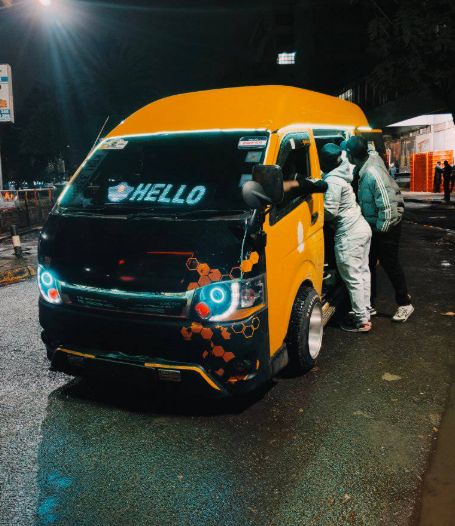So, you’re thinking about checking out Kenya, huh? And you’ve heard about matatus, those colorful minibuses that locals use all the time. Well, you’re in the right spot! Getting around Kenya can be an adventure, and while there are lots of ways to travel, hopping on a matatu is a real local experience. It might seem a bit wild at first, but with a few tips, you’ll be riding like a pro in no time. This guide will help you figure out everything from finding the right matatu to staying safe on your journey, making sure you get to see Kenya up close and personal.
Understanding Matatus: Kenya’s Iconic Minibuses
What is a Matatu?
Okay, so what is a matatu? Basically, it’s a privately owned minibus, and they’re everywhere in Kenya. Think of them as the lifeblood of public transport, especially in cities like Nairobi. While there’s a move towards bigger, more regulated buses, matatus are still super common. They’re not just a way to get around; they’re a whole experience. You’ll find them zipping all over, from downtown areas to the suburbs. They are the most used form of public transport for locals.
The Matatu Experience
Riding in a matatu is… an experience. First off, they usually leave when they’re full – and I mean full. Personal space? What’s that? But if you get lucky and snag a ride in one that’s not too packed, it can actually be pretty fun. Fares are usually fixed and pretty cheap. You pay the driver or the conductor once you’re on board. The vehicles themselves are often decked out with colorful paint jobs, sometimes with portraits of famous people or catchy slogans. And the music? Oh man, the music is usually blasting. Some even have Wi-Fi and play movies or music videos. It’s a whole vibe, that’s for sure. The matatu experience is unique.
Matatu Safety Considerations
Okay, let’s talk safety. It’s important to be aware of a few things. Seat belts are supposed to be there, but they’re not always used or even working. And the driving? Well, let’s just say it can be a bit… variable. It’s a good idea to ride with people you know, especially if you’re new to this. Try to stick to daytime travel in urban areas. Keep your luggage locked and your valuables close. And maybe avoid the front seat – just in case. Matatus are driven by young men as drivers and touts, who are incentivized by a share of the earnings to maximize profits from each trip. Regulations introduced state that all seats are supposed to be fitted with seat belts, loud music is banned, and electronic speed governors are supposed to prevent speeds above 80km/h. Passenger numbers are, in theory, strictly limited, but on many routes, especially off the main roads, the old maxim of “room for one more” still applies. Always choose one that is close to full or you’ll have to wait inside until they’re ready to go, sometimes for hours. Beware of being used as bait by the driver to encourage passengers to choose his vehicle, and equally of a driver filling his car with young touts pretending to be passengers. Always ask to get out if you’re unhappy with the driving. Prioritizing safety on public transport is key.
Navigating Matatu Travel Like a Local
Choosing Your Matatu Wisely
Okay, so you’re ready to hop on a matatu. Not all matatus are created equal. It’s like picking a taxi – you want one that looks like it won’t fall apart mid-journey. First, look for one that’s almost full. Why? Because matatu minibuses only leave when they’re packed. Waiting in a half-empty matatu can feel like an eternity. You might end up being bait, as drivers try to lure more passengers.
Also, pay attention to the matatu’s name and overall vibe. Some have names that hint at the driver’s…enthusiasm. Maybe avoid the one called “Beat the Reaper.” Just a thought. A well-maintained matatu usually indicates a driver who cares, at least a little, about safety. Don’t be afraid to ask around – locals usually know which matatus are reliable and which ones to avoid. Trust their judgment; they ride these things every day.
Paying Your Matatu Fare
Paying the fare is pretty straightforward, but it helps to know the system. Fares are usually fixed, but they can fluctuate a bit depending on the time of day and the route. Ask a local how much the fare should be before you get in, so you don’t get overcharged. Have small bills ready. Trying to pay with a large bill can be a hassle, and you might not get the correct change.
Once you’re in, the conductor will come around to collect the fare. Just pass your money to the person next to you, and they’ll pass it along. Your change will come back the same way. It’s a system built on trust, so don’t break the chain! If you’re unsure, just ask the conductor for help. They’re usually happy to assist. Remember, inter-city matatu fares are typically around Ksh3–5/km.
Essential Matatu Riding Tips
Alright, you’ve chosen your matatu and you’re ready to roll. Here are some tips to make your ride smoother:
- Find a good spot: If you can, try to get a seat near a window. It can get stuffy in there, and the fresh air is a lifesaver. Also, avoid the front seat if you can. It’s statistically the most dangerous in case of an accident.
- Secure your belongings: Keep your valuables close and out of sight. Petty theft can happen, so be aware of your surroundings. Keep your bag on your lap or at your feet, where you can see it.
- Be prepared for close quarters: Matatus are often crowded. You’ll likely be squished next to strangers. It’s all part of the experience. Try to relax and go with the flow. Stretching before you get in is a good idea, seriously.
- Know your stop: Pay attention to where you are and let the conductor know when you want to get off. Shout out your destination clearly so they can hear you over the music and chatter. Don’t be afraid to ask for help if you’re not sure where to get off. Locals are usually happy to point you in the right direction.
- Embrace the chaos: Matatu rides can be unpredictable. There might be loud music, bumpy roads, and unexpected stops. Just embrace the chaos and enjoy the ride. It’s an experience you won’t soon forget. Remember to prioritize safety record when choosing your matatu.
Alternative Urban Transportation Options
Shared Taxis: The Peugeot Option
If you’re looking for something a bit different from matatus, especially for faster trips, consider shared taxis, often called “Peugeots.” These station wagons usually fit around seven to nine people. Like matatus, they only leave when they’re full. The good thing is they’re usually not as crowded, and they tend to go straight from point A to point B without making a ton of stops. You’ll mostly find these shared taxis on set routes in the northern and western parts of Kenya. It’s a solid option if you want a slightly more comfortable and direct ride.
Utilizing Ride-Hailing Apps
Apps like Uber, Bolt, and the local Hava have become super popular in Kenya, especially in cities like Nairobi. If you don’t already use them, download one and set up an account. It’s a good idea to add a payment card that doesn’t charge extra for international transactions, since fares are in Kenyan shillings. These apps can be really convenient for getting around, especially if you’re not familiar with the area or prefer a more private ride. Plus, you can track your ride and know the cost upfront, which helps avoid any surprises. Just be aware that traffic can still be a factor, so plan accordingly.
Motorcycle Taxis: Bodabodas
Bodabodas, or motorcycle taxis, are everywhere in Kenya. They can be a quick way to weave through traffic, especially for short distances. However, they also come with some safety concerns. It’s super important to wear a helmet (make sure the driver has one for you!) and agree on the fare before you hop on. While they can be convenient, especially when you’re in a hurry, always prioritize safety. Maybe not the best choice if you have luggage or aren’t comfortable on a motorcycle, but they’re definitely a common sight and a part of the local transport scene. They are a key part of sustainable transport systems in African cities.
Inter-City Travel Beyond Matatus
While matatus are great for getting around cities and nearby towns, sometimes you need to cover longer distances. Luckily, Kenya has other options for inter-city travel. Let’s explore some alternatives to matatus for those bigger journeys.
Kenya’s Extensive Bus Network
Buses are a super common way to travel between cities in Kenya. Several companies operate bus routes that cover almost the whole country. Some of the buses, especially on the main routes like Nairobi to Mombasa, are pretty comfortable and even stick to a schedule. It’s a good idea to reserve seats in advance, especially on those popular routes. You can usually find ticket offices at or near the bus stations. Just ask around at the bus park; people are usually happy to point you in the right direction. Buses are generally a safe and reliable option, but always be aware of your belongings.
Train Travel in Kenya
Train travel is making a comeback in Kenya! The Madaraka Express train runs between Nairobi and Mombasa. It’s a much more relaxed way to travel compared to the bus or matatu. The train passes through some beautiful scenery, including Tsavo East and Tsavo West National Parks. You might even catch a glimpse of Kilimanjaro! There are also trains to other destinations, like Nanyuki and Kisumu, offering scenic routes to different parts of the country. Check the schedules and book your tickets in advance, as they can sell out quickly. It’s a great way to experience Kenya’s train system.
Domestic Flights for Longer Distances
If you’re short on time or traveling to a more remote location, domestic flights are an option. Several airlines operate flights between major cities and tourist destinations. Flying is definitely the most expensive option, but it can save you a lot of time. Consider booking in advance to get the best deals. It’s also worth checking baggage allowances, as they can vary between airlines. For example, a flight from Nairobi to Mombasa is much faster than a bus, but it will cost significantly more. If you are planning to visit the coast, consider domestic flights to save time.
Planning Your Journey and Staying Safe
Considering Travel Time and Comfort
Okay, so you’re thinking about hopping on a matatu. Awesome! But let’s be real, these aren’t exactly luxury coaches. Travel times can be unpredictable. What looks like a two-hour trip on a map can easily turn into four, thanks to traffic, unexpected stops, or just the general vibe of Kenyan roads.
Comfort is another thing to keep in mind. Matatus are often packed, especially during peak hours. You might find yourself squeezed between people, luggage, and maybe even a chicken or two. If you’re doing a longer trip, think about bringing some water and snacks. Also, consider the time of day. Early morning or midday trips might be less crowded than rush hour. Here’s a quick look at typical travel times between major cities:
| Route | Estimated Time | Notes |
|---|---|---|
| Nairobi to Mombasa | 6-8 hours | Can vary widely based on traffic. |
| Nairobi to Kisumu | 5-7 hours | Expect delays due to road conditions. |
| Mombasa to Malindi | 2-3 hours | Coastal route, generally smoother. |
Prioritizing Safety on Public Transport
Safety first, always! Matatus, and buses to a lesser extent, sometimes have a bad safety record. The so-called “express” matatus? Yeah, they really mean it, and not in a good way. Don’t be afraid to speak up if you feel unsafe. If the driver is speeding or driving recklessly, ask to be let out. Seriously. Demand a partial refund; they’ll usually give it to you.
Also, keep an eye on your belongings. Petty theft can happen, especially in crowded vehicles. Keep your phone and wallet secure. Avoid traveling alone at night if you can. If you have to, consider a shared taxi instead of walking. It’s also a good idea to let someone know your travel plans and estimated arrival time.
Managing Luggage and Valuables
Luggage can be a bit of a hassle on matatus. Space is limited, so try to pack light. Duffel bags are better than hard suitcases because they’re easier to squeeze into tight spaces. Keep your valuables with you, not in your checked luggage (if there even is checked luggage). Be aware of your surroundings when loading and unloading your bags. Don’t pay extra for your luggage. If they ask, tell them kindly that your luggage can fit on the roof or under your seat; if not, find another van. Malleable duffels in a dark color are great at handling a rough and tumble matatu. Your bag will inevitably be squished up against something gross and possibly sat on by a shady character up on the roof so these two items will let you roll with the punches.
Embracing the Local Travel Culture
Okay, so you’re ready to ditch the tourist traps and really see Kenya. That means diving headfirst into the matatu experience. It’s not always pretty, but it’s real, and it’s where you’ll find the heart of the country. Forget sanitized tours; this is about connecting with people and getting a taste of everyday life.
The Unofficial Matatu Capital of the World
Nairobi definitely earns the title of matatu capital. It’s a chaotic ballet of color, sound, and motion. You’ll see matatus decked out in everything from religious slogans to pop culture icons. The music blasting from the speakers? It’s a whole vibe. It’s loud, it’s intense, and it’s undeniably Kenyan. Other cities have matatus, sure, but Nairobi? It’s on another level. Think of it as the Times Square of public transport, but with more personality (and maybe a little less personal space).
Immersing in Local Culture
Riding a matatu isn’t just about getting from point A to point B. It’s a cultural exchange. Pay attention to the conversations around you. Watch how people interact. You might pick up some Swahili phrases, learn about local issues, or even make a new friend. Don’t be afraid to ask questions (politely, of course!). Most Kenyans are happy to share their culture with visitors. Just remember to be respectful and open-minded. It’s a chance to see the world from a different perspective, and that’s what travel is all about, right?
Here are some ways to immerse yourself:
- Learn a few basic Swahili phrases: “Jambo” (hello), “Asante” (thank you), and “Samahani” (excuse me) will go a long way.
- Try local snacks: Keep an eye out for vendors selling street food near matatu stages. It’s a cheap and tasty way to experience Kenyan cuisine.
- Listen to Kenyan music: Pay attention to the music playing in the matatus and ask the driver or conductor about the artists. You might discover your new favorite song.
Finding Humor in the Journey
Let’s be honest, matatu travel can be… challenging. Overcrowding, bumpy roads, unexpected stops – it’s all part of the adventure. But instead of getting frustrated, try to find the humor in it. Laugh along with the locals when the matatu breaks down (it happens!). Smile when the conductor crams one more person into an already packed space. These are the moments you’ll remember long after you’ve left Kenya. It’s about embracing the chaos and finding joy in the unexpected. After all, a little bit of humor can make any journey more enjoyable.
So, What’s the Takeaway?
So, there you have it. Taking a matatu in Kenya might seem a bit much at first, but it’s a real way to see the country. You get to ride with locals, see things you wouldn’t from a regular taxi, and honestly, it’s pretty cheap. Just remember to keep your wits about you, maybe don’t ride at night, and try to go with someone if you can. It’s not always the smoothest ride, but it’s definitely an experience you won’t forget. Give it a shot; you might even have some fun.
Frequently Asked Questions
What exactly is a matatu?
Matatus are shared minibuses, often brightly decorated, that serve as a main way for Kenyans to get around, especially in cities like Nairobi. They are privately owned and leave when they’re full.
Are matatus safe to ride?
Matatus are generally safe for short trips during the day. It’s smart to travel with others if you can. Always keep your bags locked and your important items close to you. Try to avoid sitting in the front seat next to the driver because of crash risks.
How do I pay for a matatu ride?
You pay the driver or a helper, called a conductor, once you’re on board. The prices are usually set and won’t break the bank.
Are there other ways to travel in Kenyan cities?
Yes, there are other ways to get around. Shared taxis, sometimes called ‘Peugeots,’ are good for fixed routes and are less crowded. You can also use ride-hailing apps like Uber or Bolt. For quick trips, motorcycle taxis, known as ‘bodabodas,’ are common.
What about traveling between cities in Kenya?
For longer trips between cities, Kenya has a big bus system. You can also take a train, like the one from Nairobi to Mombasa, which offers nice views. For very long distances, flying is an option.
Why is Nairobi known for matatus?
Nairobi is sometimes called the ‘Matatu Capital of the World’ because matatus are such a big part of daily life there. Riding a matatu is a great way to see how locals live and experience the culture firsthand.






